Last week I had the opportunity to go to Kerr Dairy, a family owned dairy farm right here in Arizona.
It was such a neat experience and I recommend it to anyone who is interested in knowing where their milk comes from.
I had no idea how complex the life of a dairy farmer was. Before the tour I simply thought that dairy farming consisted of milking cows by hand into a metal bucket, while sitting on a little wooden stool and wearing overalls with a piece of hay sticking out of the back pocket.
A little too much “Old House on the Prairie.” I suppose.
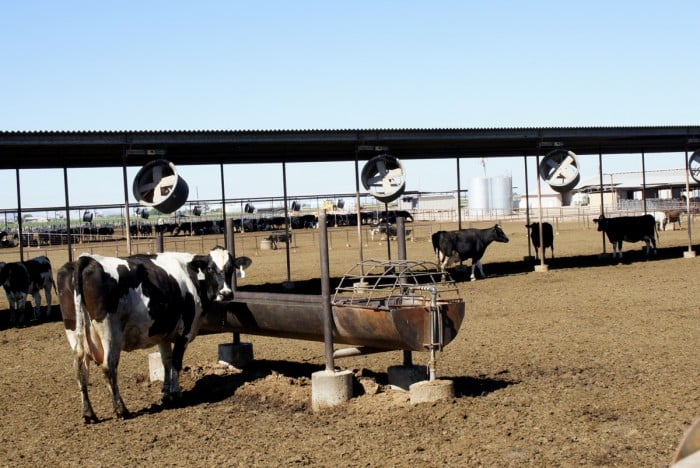
Did you know that Arizona is one of the largest producers of milk?
Yes, you heard! Right here in the desert, our state is home to many large dairy farms. Our climate is so perfect for these beautiful bovines that they thrive and are able to produce up to 100 pounds of milk in one day {that’s 160 glasses!}.
But there is so much science and technology to it, that it blew my mind.
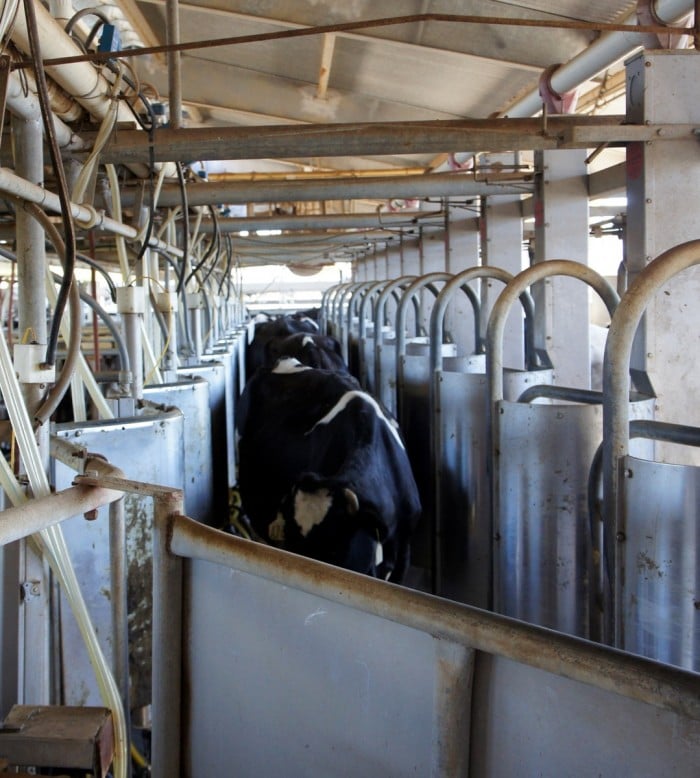
If you’re a mom and have ever nursed a baby… then you can quickly relate the experience to how a cow is milked. They actually love the feeling of being milked. It relieves the pressure in their udders, and that makes for one happy cow, and for a lot of happy milk drinkers.
The cows are all categorized into stages of milk producing, baby rearing, and even “taking it easy.”
Similar to how a woman would produce a lot of milk after having her baby, these cows have just had babies {the gestation period for a cow is 9 months} and are now ready to have their milk pumped. They line up when it’s time to milk and wait patiently for their turn in the milking stalls. The cows walk down the line and back up their rear ends.
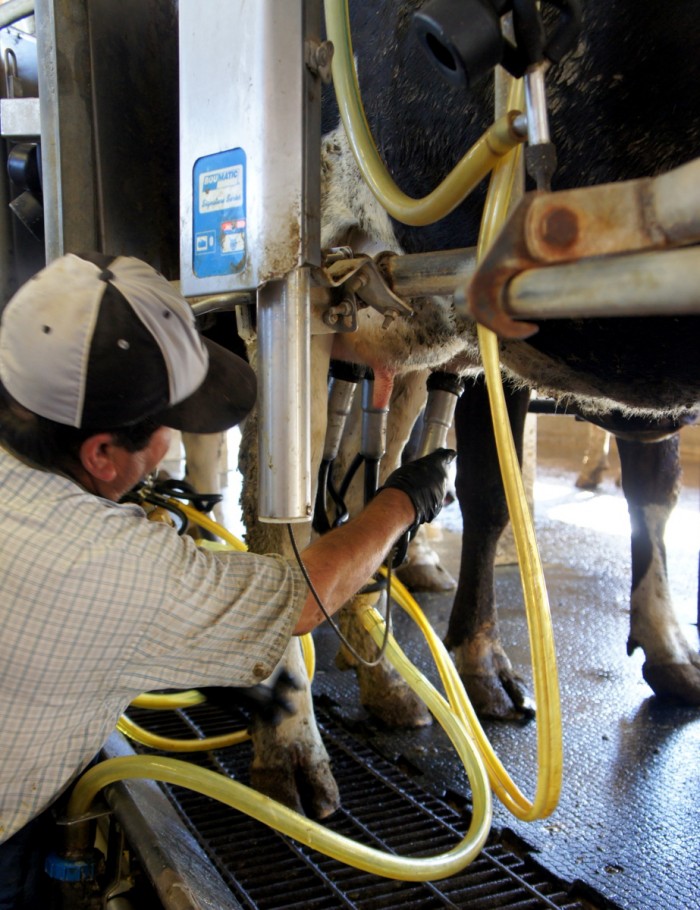
The udders are cleaned thoroughly before the suctioning devices are attached {think breast pump}. It takes approximately 8 minutes for the cow to be milked.
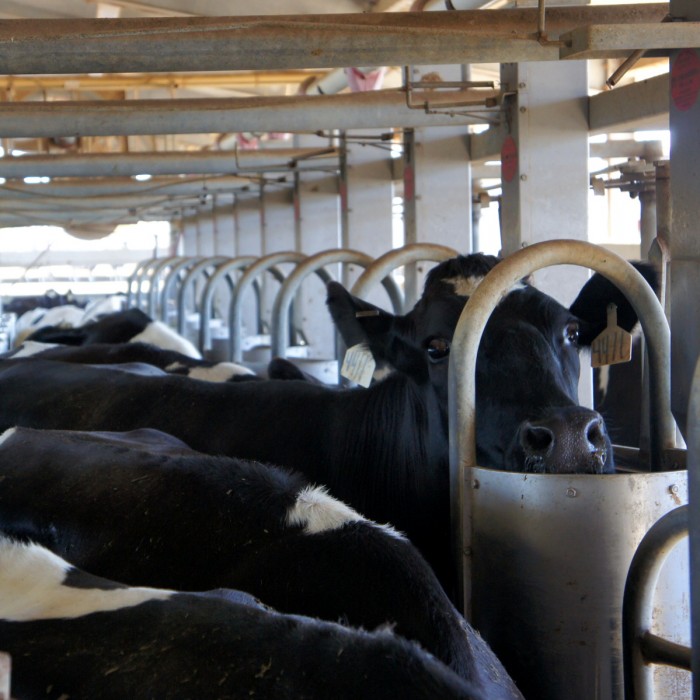
What shocked me the most was how calm and surreal the whole situation was. I expected to see some cows getting a little antsy and maybe some pushing and shoving… but no, these cows were so happy.
And that’s exactly the way they want it at the dairy. A happy cow produces more milk.
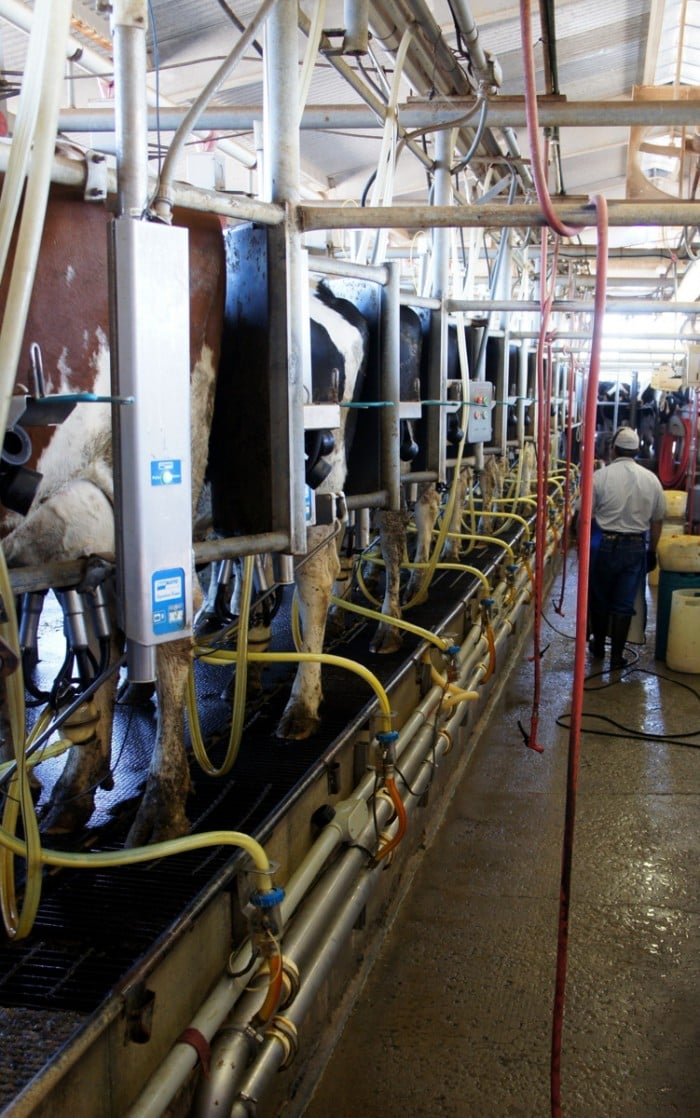
After the cows are milked the stalls are opened and they patiently wait their turns to exit. Seriously, so amazing to watch.
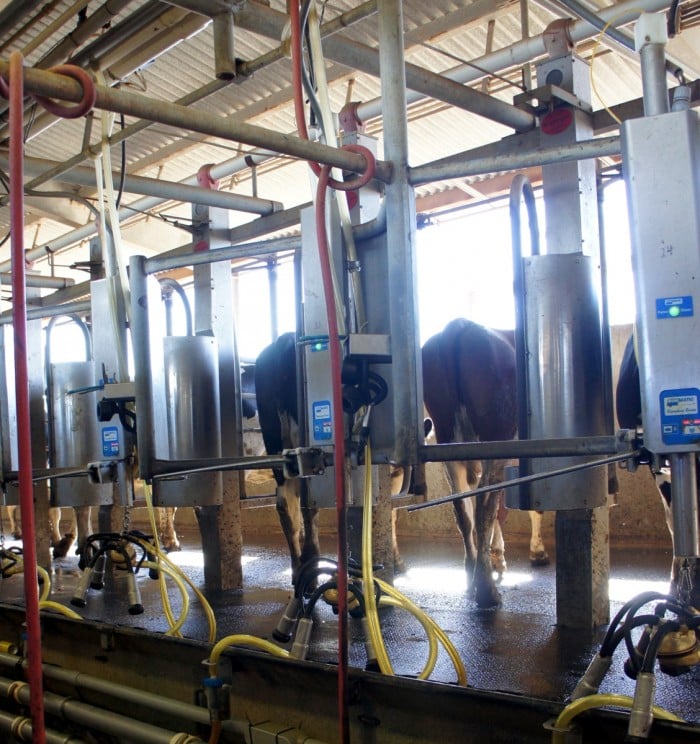
Pardon their dairy-aire’s. hehe…
So what happens to the milk after it’s pumped?
Well it’s quickly transferred through pipes to the next room where it is instantly cooled down to 36 degrees. This helps to ensure that no bacteria grows in the milk.
Meet Wes Kerr, he is the 4th generation dairy farmer at Kerr Dairy Farm, and nice enough to take time out of his busy day to educate us.

He is holding onto the pipe that cools the milk down and right behind him in that big tank is where the milk is pumped into. It stays chilled and has paddles inside that are slowly spinning to make sure the cream doesn’t settle on top. From there a truck comes to pick up the milk and take it to get pasteurized and homogenized.
The milk could be purchased at the store as early as 2 days after being pumped.
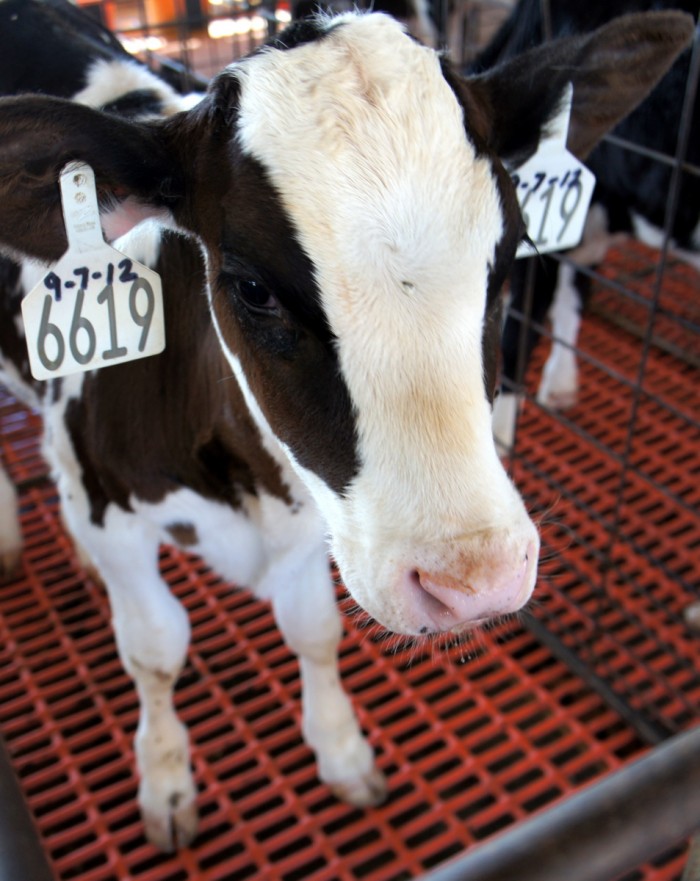
Wes cleared up a lot of questions I had about whether or not cow’s milk had hormones in it. I had always heard that farmers gave cows the RBST hormones to make the cows produce more milk. Not the case for Arizona Farms. The dairy farmers in Arizona all signed pledges to not use the RBST hormones.
But to clear it up even more… there are no hormones in milk at all. The thing that dairy farmers, and Wes, look out for is when a cow is sick and needs antibiotics. Those antibiotics can find their way into a cow’s milk supply, which is not good. The milk will not pass inspection and the whole lot will get turned away.
So what farmers do is have a “hospital” section at the dairy where sick cows have to take their meds and wait it out. Much like if you were nursing a baby and had to do the “pump-and-dump,” the milk that is produced from a medicated cow gets tossed out.
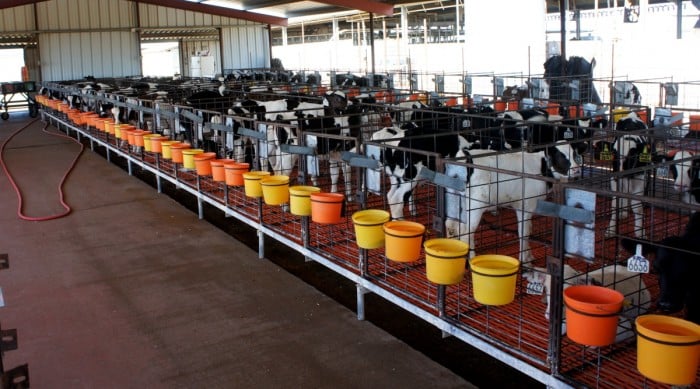
After a mama cow has her baby, the calf is taken to this special area where they are bottle fed 3 times a day, and given as much water and food as they desire. They are elevated off the floor so that underneath them can remain clean.
They are kept in separate stalls so they can make sure each and every calf is getting the right amount of food and water. They only stay here for a few weeks until they move on to the next phase of cow-hood.
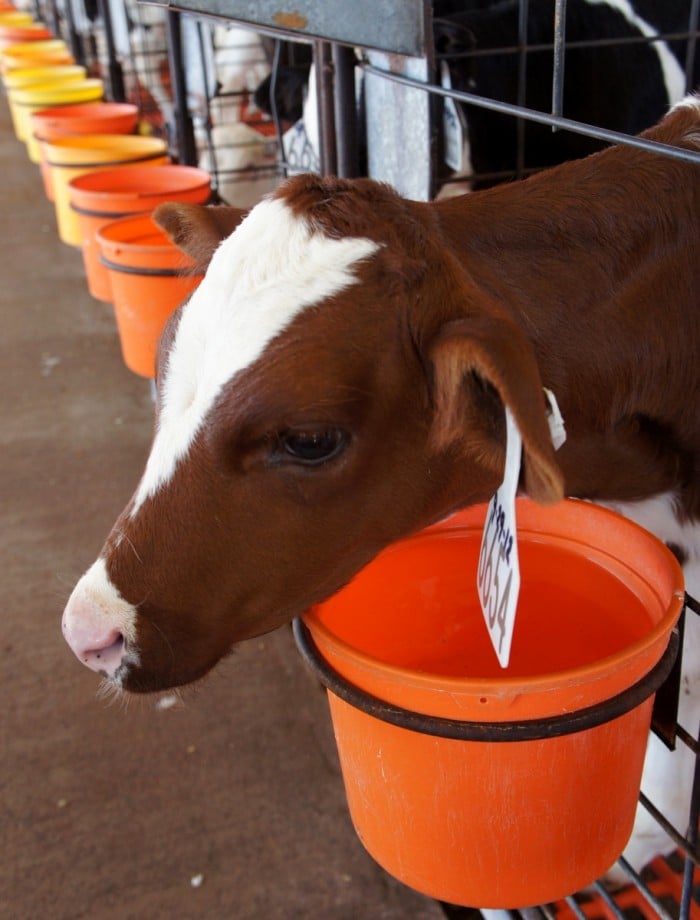
Those babies sure are cute.
Wes showed us the dairy’s fields of alfalfa, which grows in abundance all year long here in Arizona.
When it comes to feeding a cow, I never thought of it being more than just a bucket of hay. It’s so much more than that. There is an actual science to it. The dairy has a nutritionist that comes out to make sure the cows are being fed properly and getting the right balance of nutrients.
It’s a full time job to be a dairy farmer.
I asked Wes if he ever gets to go on vacation. Him and his father trade off, he said.
He is such a kind and caring man, and so in tune with these cows. He talked about how “you can just tell when a cow isn’t feeling good.” Their posture, the way they stand, or how they chew are all indicators that help him make the right decisions on how to care for his cows.

This is Wes Kerr.
Son, Husband, Father, and 4th Generation Dairy Farmer.
This is his beautiful wife and adorable daughter, who he hopes one day will be the 5th generation dairy farmer.
If you have any questions about the process please ask! I didn’t share everything {information over-load}, but I would love to help answer any questions you might have. Special thanks to AZ Milk Producers for setting up this tour!

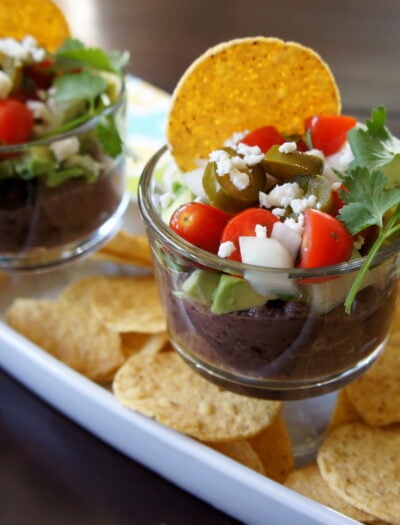
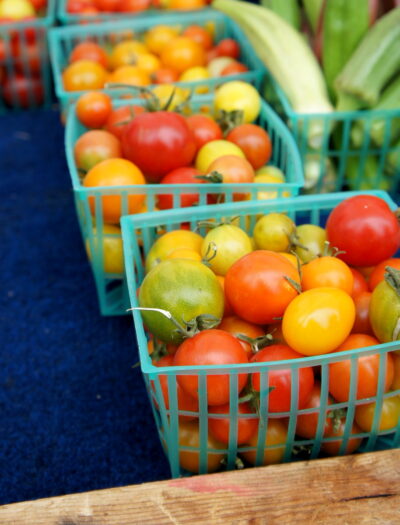

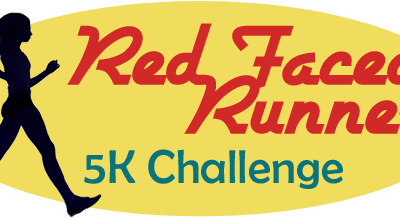
This is such a wonderful piece you’ve written–I’ve been absolutely fascinated with the ways local farms treat their livestock ever since I started reading works by Michael Pollan. Have you read anything by him before? It always gives me such a great science to see what people can do when they slow down and take the time to really treat the animals that produce so much for us right. Any idea how the average layperson could set up a tour for something like this? And when it comes to their diet, do dairy farms like the one you looked at ever encourage a more rotational grazing-type model, or do most of them keep the cows fed in stalls?
Very thorough! I was impressed by your experience and the time you took to listen and learn. I have often thought that we (as dairyman) need to develop a nation-wide network of farmers willing to have guests onto the farm to show interested consumers how their food is produced. I have had that vision for quite some time and had even purchased and started developing www.dairymanforaday.com so others could enjoy the same ag experience, but lacked time and outside interest to continue pursuit. Thanks for your blog.
The only thing that I would correct is that you stated no milk has hormones, when in fact, all milk contains hormones like naturally-occurring BST (Bovine Somatotropin).
As a mom you should be able to empathize with these “happy” cows who would much rather suckle their babies than metal suction tubes (which are known for applying too much force and causing all kinds of injuries). As for the babies, what IS the next step to cow-hood? For the boys, a veal pen? The farmer was great at showing you exactly what he wanted you to see. The more I learn about the ways they treat ag animals, a plant-based diet becomes the only way I feel I can stand before God and say I did the right thing.
Hi Emily, great questions!
The babies are still fed the colostrum and bottle fed 3 times a day, but for sanitary reasons they are not allowed to suckle. It could cause an infection. The “metal tubes” actually have a rubberized suction on the inside so it’s not uncomfortable for the cow. (If you have ever used a breast pump, that is what it is similar to) If it was a painful process, I don’t think the cows would line up willingly (and on their own) to have it done 😉
When the babies move out of the baby pens they are put into a field where they will be fed and cared for just like all the other cows until they are ready to have babies and then the cycle continues.
As far as the farm I went to was concerned, some of the boys stayed on the farm for reproduction purposes, and some the rest are sold to other farmers. Which I am sure will be raised for beef.
I was able to see the whole farm, and I could tell that this farmer genuinely cared for his cows. He showed me all the steps they take to make sure the cows are happy.
As for “I can stand before God and say I did the right thing,” I believe that God put animals on the earth for our use. (Gen 1: 28-30) But I also believe that everyone is entitled to their own opinion on that. I just wanted to share and clear up any misconceptions people might have about dairy farming.
I hope I answered all your questions! 🙂
This is SO great! I am all about knowing where my food comes from. I have been doing a lot of research lately on this very subject. What a great experience!
What a cool post!! Thanks for sharing your experience!